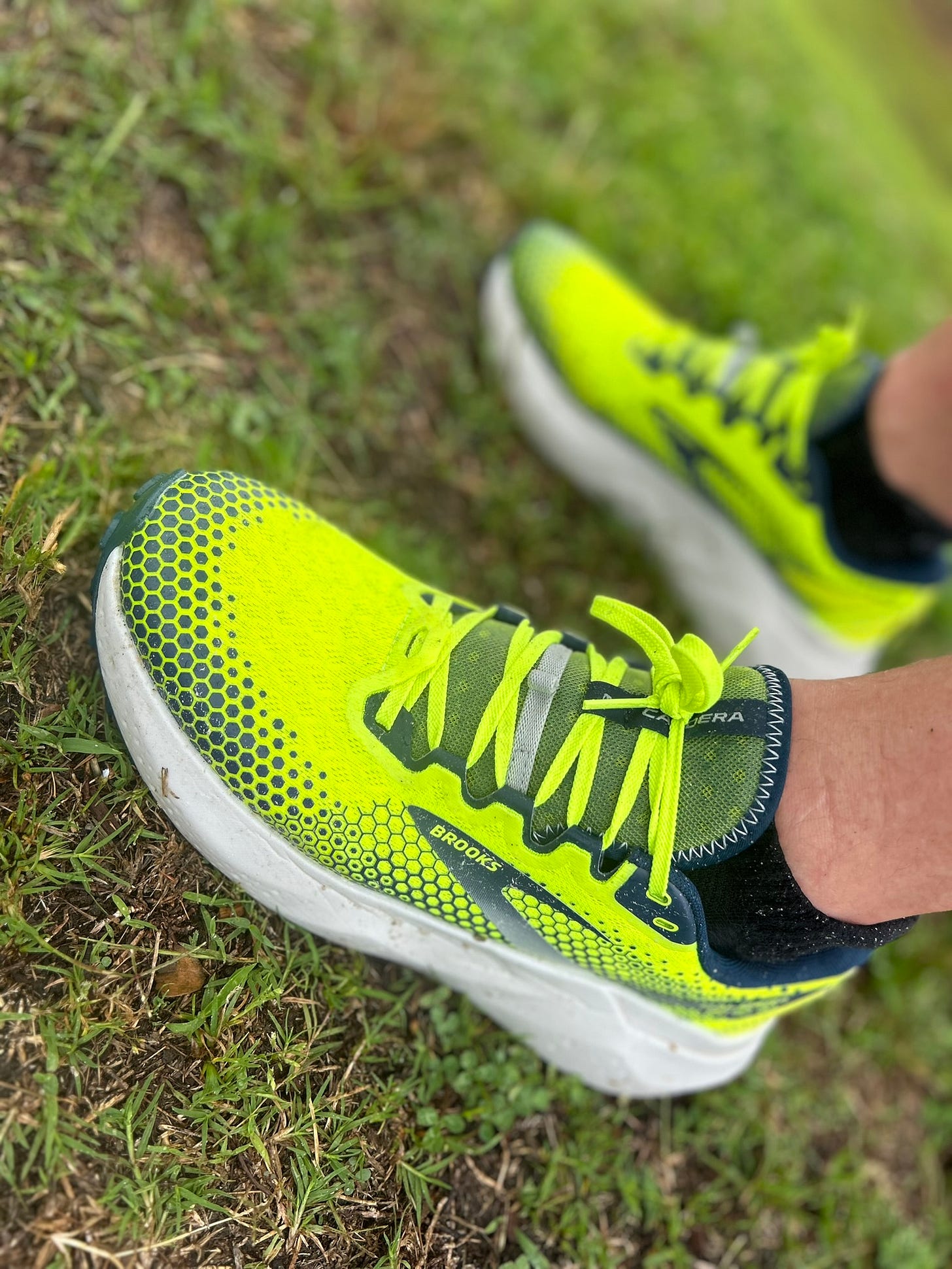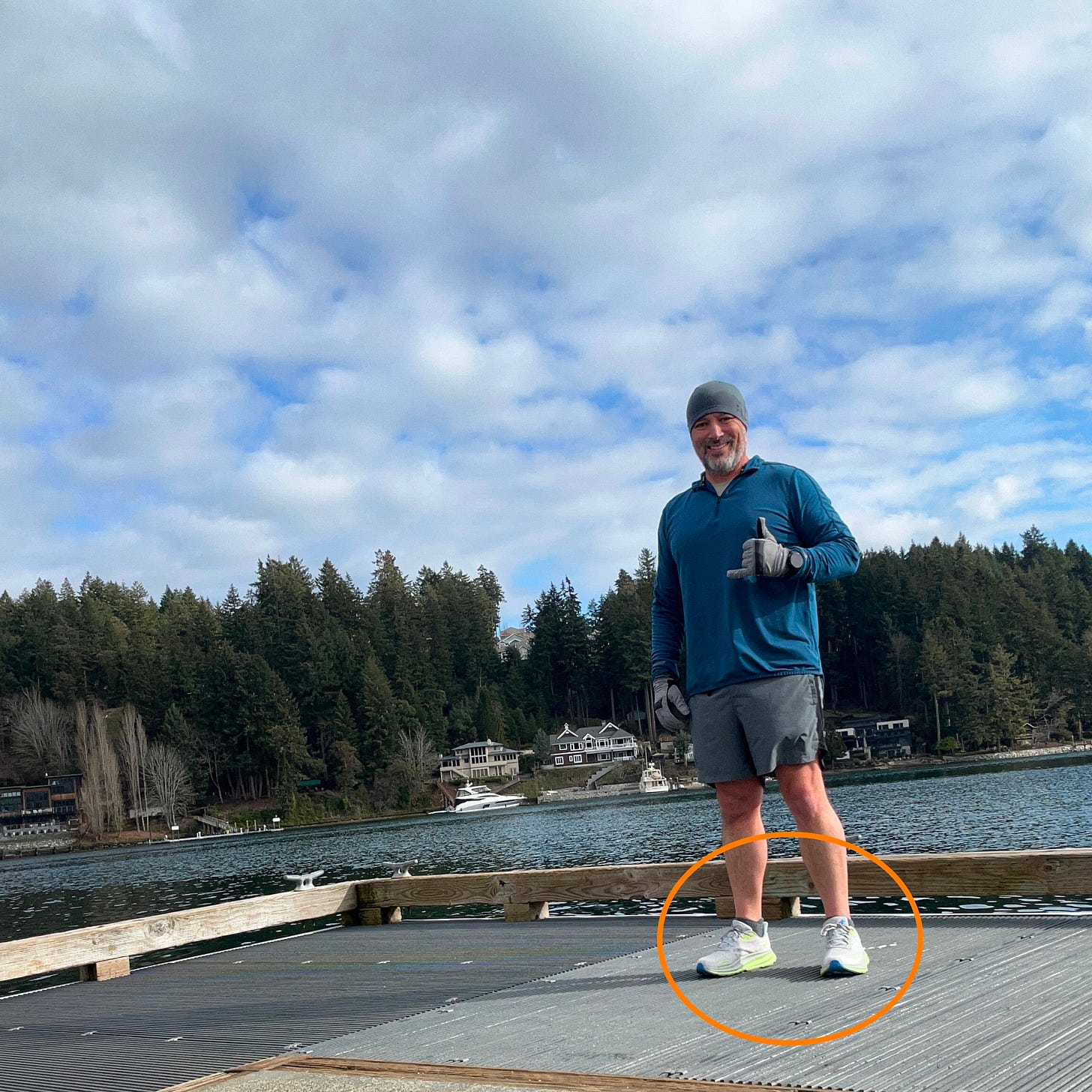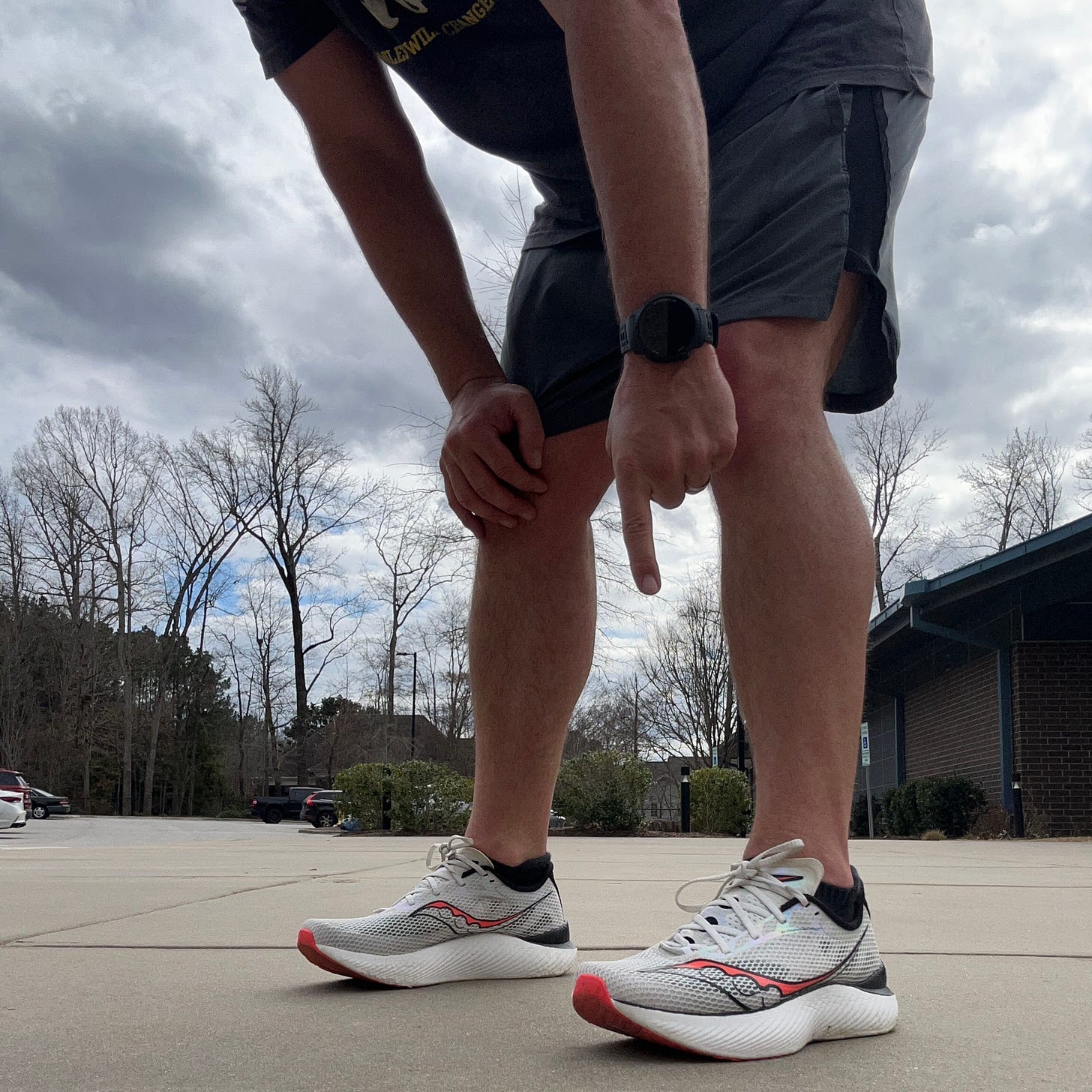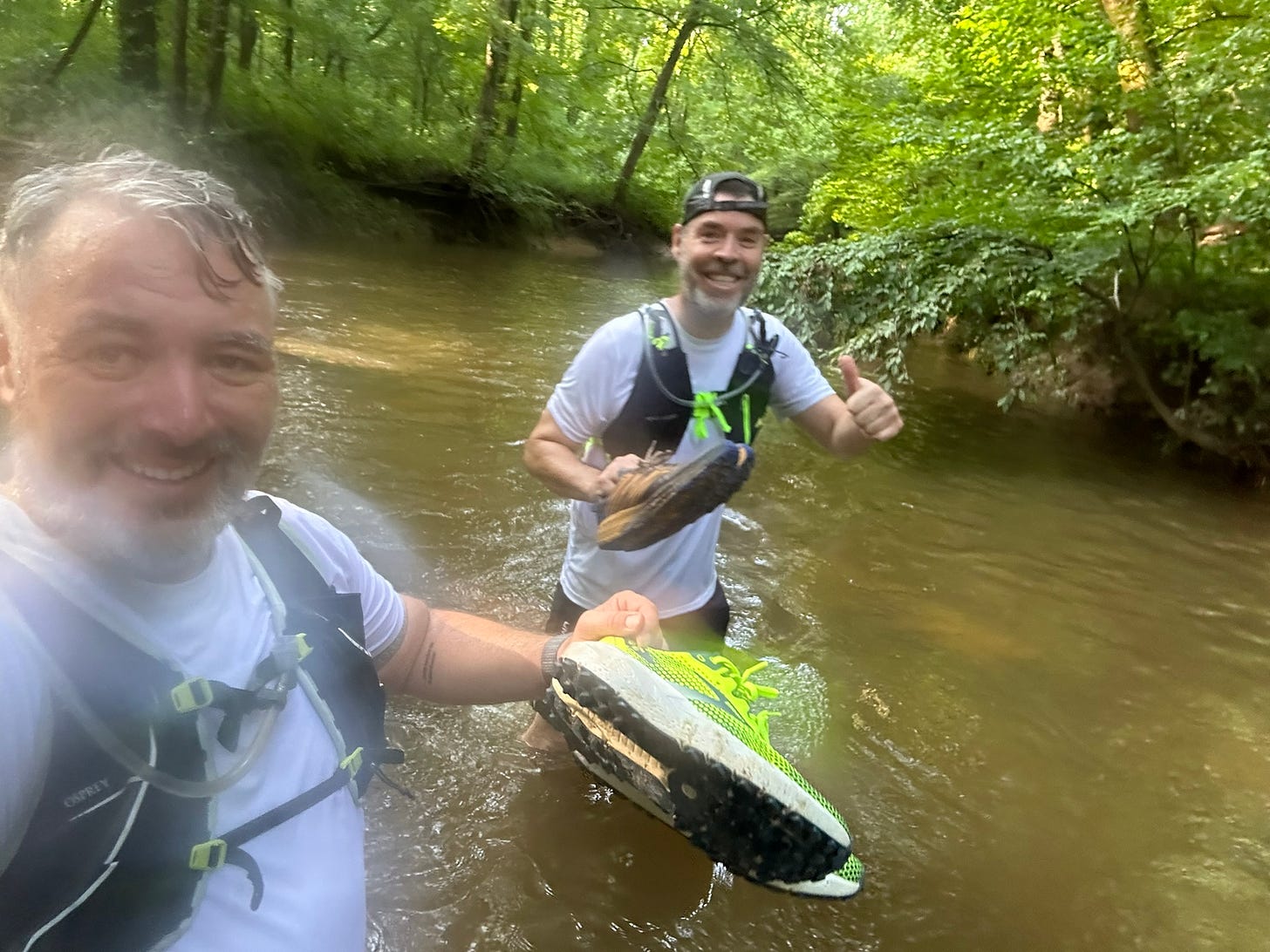Get in line! Shut the fuck up! Does the shoe fit?! Good. MOVE OUT!
That was as much attention that I received from the person helping me find my first pair of “running shoes”. Except these weren’t running shoes and I wasn’t there to become a runner, even thought that’s what really happened.
It was 1999 and the U.S. Army found it best to send me to Fort Sill, OK to attend One Station Unit Training (OSUT). A combination of Basic Training and Advanced Individual Training (AIT). I was getting fitted for “Physical Training Shoes” or PT shoes. Little did I know that in the U.S. Army, PT shoes are universal. They were used for everything from running, to pushups, obstacle courses, rope climbing, track work, weight lifting, LOG PT (IYKYK) and much more. We ran on the road, dirt trails and through creeks and mud. They were nothing more than a tool for universal application of physical training.
That BS stuck with me. For way too long. 19 years too long.
In the picture above you can see that I’m running the Army 10-miler circa 2009 in a pair of Asics cross trainers. I would do everything in these shoes. They were my “PT” shoes, so they were versatile, but not meant for running. Despite this fact I ran over a dozen Army 10-milers in these “PT” Shoes and did fairly well.
You can read about the beginnings of my running journey over 26 years ago when I wrote The Trailhead back in July of 2022.
Brooks Ghost 10: The F150 of Running Shoes
It wasn’t until 2018, a mere 19 years after that crazy day in Oklahoma, that I walked into a Fleet Feet store to get properly fitted for and purchase my first pair of dedicated running shoes.
There’s a reason the Brooks Ghost series is often in the top three running shoes year over year. They are a work horse! They are reliable, durable and proven. Like the F150, when you buy a pair of Ghost, you know they’ll work and get the job done.
I wore them for five years, upgrading every year until 2023 when I switched to the Brooks Hyperion for the Richmond Marathon in November 2023. I really enjoyed those racing shoes for the Marathon and set a new PR at 4:19! I still have those shoes and wear them whenever I’m racing from the 5K distance and up.
The F150 of running shoes have proven themselves to me time and time again. The Brooks Hyperion felt great and I really enjoy them. So when it came to some trail shoes, I stuck with Brooks and purchased the Cascadia and Caldera.
The Brooks line of shoes have treated me well and I believe have helped keep me relatively injury free since I first started wearing them.
Is the grass really greener on the other side?
When was the last time I saw someone win a Worlds Major Marathon in a pair of Brooks? I really can’t remember. I’ve spoken to a handful of Boston Qualifying runners in person, and none of them ever did it in a pair of Brooks. I follow a lot of runners on Instagram, some famous, most are not and even fewer are qualifying for Boston. Of those BQ runners, I can’t think of one who did it in a pair of Brooks.
Identifying trends and conducting pattern analysis to predict future outcomes is part of my professional repertoire.
I’ve decided to venture out this year to see if I can find another brand that will help me reach my goals.
In these first three months of 2025 I've acquired three new pairs of shoes from three new companies.
HOKA: Clifton 9
New Balance: 1080v14
Saucony: Endorphin Pro 3
The Rotation
I’m not sure when it happened, but I know why it happened.
I’m getting closer and closer to reaching the same quantity of shoes as my wife! While most of her collection is for fashion and to accentuate her already stunning looks, my goal is rather simple. I just want to go fast and stay pain and injury free! I don’t care how I look, unless I look FAST, then the goal was met.
Some of the best advice ever given to me about shoes was from my close friend Dave. An Ultra Runner with a BQ under his belt along with decades of running relays across the country.
“Rotate your shoes. When you’re logging over 100 miles per month you should really be rotating between three and four pairs of shoes.” - Dave
He gave me this advice when I was training for my first Marathon in 2022. The City of Oaks Marathon where I nearly DNF’d with a time of 5:54
Regardless of the outcome of that race, the advice to rotate shoes kept me injury free.
So here’s my current shoe lineup:
Brooks Hyperion Tempo: Treadmill Runs of 4-miles or less.
Brooks Ghost 15: Easy, social runs of any mileage from 3-miles to 13.1 miles.
Brooks Hyperion: These are my RACE shoes. For all races 5K to The Marathon.
New Balance 1080v14: Daily Trainer and Long Distance Runs.
Hoka Clifton 9: Daily Trainer and Long Distance Runs.
Saucony Endorphin Pro3: Still learning this shoe, but will likely be used for weekly Threshold Runs of 4 miles and more.
Brooks Caldera: Trail Shoes with a very soft sole. I use these on hard, compact trails with roots and rocks.
Brooks Cascadia: Trail shoes with a firm sole. I use these for trail runs with a soft trail such as soft, deep sand and mud.
The Rotation:
Monday: Road Running - 1080v14
Tuesday: Treadmill - Hyperion Tempo
Wednesday 5K: Clifton 9
Thursday 5-miler on the road (Fast): Endorphin Pro3
Friday: Road Run - 1080v14 or Trail Run: Caldera
Saturday: Clifton 9 or Ghost 15
Sunday Long Run: NB 1080v14
Road Races: Hyperion’s or Endorphin Pro3
Finding the right tool for the right job.
It’s important to find the right running shoe for you and your goals.
Improper shoes can cause foot, ankle and knee pain which will cause your running gait to change. Once your gait changes, then your core needs to compensate for the imbalance in your running posture. This can lead to back pain, shoulder pain and sore or fatigued abdominal muscles. All of this is caused by an improper fitting shoe.
A properly fitted shoe will allow you to run without those externally imposed pains on the body. For many of us, running is already hard, don’t make it additionally painful by using an improper shoe.
As you read above, I have a rotation of shoes for different running conditions. From the treadmill to road racing and for different trail conditions. You can prevent injury by using the right tool for the right job. Road racing shoes generally have very little traction and are designed for a lifespan of 200 miles or less. (Yikes, this comes out to $1 to $1.50 per mile!) Using a road-racing shoe for a trail run can and will most likely lead to injury as you won’t have the proper traction and a slip and fall is likely.
There are a few things to take into consideration before you spend your hard earned money on new running shoes.
How many miles a week will you be running?
Do you plan on having a 2-shoe rotation or more?
What trail conditions will most of your miles be on? (sidewalk, dirt trail, gravel road, paved road, etc)
What weather conditions will most of your runs be in? (dry, rain, snow, sleet, etc)
Do you need a specific type of shoe for your goals? I.E: A daily trainer or a Racing Shoe.
What is your budget?
Maybe you’re a walker and need something designed for long walks. (yes, there is a difference between walking shoes and running shoes by design)
Here’s a few easy things to remember about your investments:
Never lift weights in your running shoes.
Never run in your lifting shoes.
Never “ruck” or carry heavy hiking packs in your running shoes.
Rotate your running shoes every other run.
Keep them dry and clean. Yes, they’ll get wet and dirty, clean them before you place them up to dry.
How to find the right shoe.
Remember this:
What works for your friend may not work for you.
That “runner - influencer” may be getting paid for endorsements.
A higher price doesn’t mean it’s more comfortable or durable.
I recommend finding a Running Shoe store that has a foot analysis machine that will scan your foot and provide details about the size, shape and pressure patterns of your feet. Fleet Feet has these scanning machines, but so do many local, independent retailers. The scans are almost always free and this will provide a great starting point for finding the right shoe.
Go to a store that has a great return / trade in policy. What may feel great in the store, may not feel so great once you’re 20 miles into using them. Having the ability to return them and trade them in for a new pair will help you refine your choice.
While in the store, try on multiple pairs of shoes from multiple brands. Find what feels best for you. Each brand has different sizing and not all sizes are the same. My Brooks Ghost’s are all 9.5D while my New Balances are 10D and the Saucony’s are 10.5D. Yet they all fit the same!
Wear some running clothes when you go shopping for running shoes. Often times, running stores will have a treadmill in store to try out the shoes. Do it! Get on the treadmill, set the incline to 1% and get in a short 1/4 mile or 1/2 mile jog to see how they feel. Look for foot rotation, knee rotation or any other indication that your lower body is moving left to right instead of forward. Efficient running is a forward movement with as little left-to-right oscillation as possible. Your body will naturally sway but don’t make it more prominent by an improper shoe.
For all of these reasons listed above I highly recommend to buy in person and not online for your first pair of running shoes or if you plan on changing brands. Once you are familiar with a brand or style of shoe, then purchasing them online will most likely work out.
Another great option is to find a local Run Club when they are having a “shoe demo” day. Many local running stores will hold a “demo” day where you can try on new running shoes and use them on a run in your local area. This is a great way to get real-world feedback on what works for you.
In addition to everything you’ve read above, there is another class of running shoes called “Super Shoes”. These are the elite level shoes designed for use in just one race with a few training runs leading up to the race. Often these shoes are carbon plated and integrated with the latest technology backed by research and science to help runners reach peak performance.
These “super shoes” can range from $250 - $500
Nike Alphafly3 is a proven race shoe and starts at $285
Adidas Adizero Pro Evo 1 starts at $500
Hoka Rocket X 2 starts at $250
Brooks Hyperion Elite 2 starts at $250
New Balance FuelCell Super Comp Elite 3 starts at $230
Altra Vanish Carbon 2 starts at $260
Mizuno Wave Rebellion Pro 3 starts at $250
These “super shoes” are not daily trainers. They are expensive, technologically advanced and can be the small difference between a runner meeting their or falling short by mere seconds.
I’m still on the search for what my Mesa Marathon race shoe will be. Follow my journey as 2025 continues in my build towards a Boston Qualifying run.












